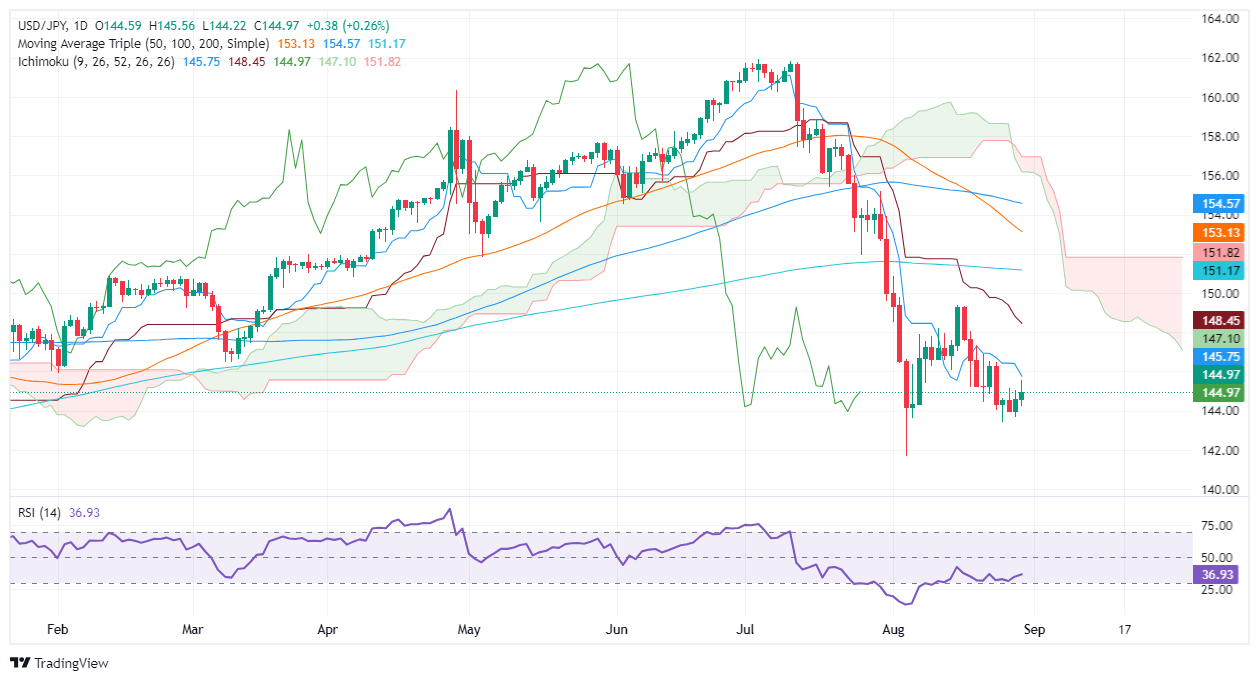- Bearish technical outlook persists; pair remains below Ichimoku Cloud and 200-DMA, hinting at further declines.
- RSI suggests seller dominance, despite a temporary buyer-led recovery.
- Resistance levels to watch: 145.39 (Tenkan-Sen), 146.00, 146.92 (Senkou Span A), 148.45 (Kijun-Sen).
- Downside break below 144.00 targets 143.44 (August 26 low), with potential to test monthly low at 141.69.
The USD/JPY registered modest gains during the North American session on Thursday of over 0.27%. During the trading day, the pair retreated to a daily low of 144.22 but bounced off and ended the session near the 145.00 figure. At the time of writing, the major trades at 144.97 were virtually flat as Friday’s Asian session began.
USD/JPY Price Forecast: Technical outlook
From a technical perspective, the pair is downward biased despite registering a leg-up. Once the USD/JPY slid below the Ichimoku cloud and the 200-day moving average (DMA), it opened the door to posting a multi-month low of 141.69. Since then, the major enjoyed an uptick but failed to gain traction to clear the 150.00 figure.
The Relative Strength Index (RSI) shows sellers are in charge, although buyers enjoy a short-term leg-up.
If USD/JPY decisively clears 145.00, this could pave the way for further upside. Once it moves up, the first resistance would be the Tenkan-Sen at 145.39, followed by the 146.00 figure. Up next would be the Senkou Span A at 146.92, ahead of testing the Kijun-Sen at 148.45.
Conversely, if sellers push the exchange rate below 144.00, the next support would be the August 26 daily low of 143.44. A breach of the latter will expose the August monthly low of 141.69.
USD/JPY Price Action – Daily Chart
Japanese Yen FAQs
The Japanese Yen (JPY) is one of the world’s most traded currencies. Its value is broadly determined by the performance of the Japanese economy, but more specifically by the Bank of Japan’s policy, the differential between Japanese and US bond yields, or risk sentiment among traders, among other factors.
One of the Bank of Japan’s mandates is currency control, so its moves are key for the Yen. The BoJ has directly intervened in currency markets sometimes, generally to lower the value of the Yen, although it refrains from doing it often due to political concerns of its main trading partners. The current BoJ ultra-loose monetary policy, based on massive stimulus to the economy, has caused the Yen to depreciate against its main currency peers. This process has exacerbated more recently due to an increasing policy divergence between the Bank of Japan and other main central banks, which have opted to increase interest rates sharply to fight decades-high levels of inflation.
The BoJ’s stance of sticking to ultra-loose monetary policy has led to a widening policy divergence with other central banks, particularly with the US Federal Reserve. This supports a widening of the differential between the 10-year US and Japanese bonds, which favors the US Dollar against the Japanese Yen.
The Japanese Yen is often seen as a safe-haven investment. This means that in times of market stress, investors are more likely to put their money in the Japanese currency due to its supposed reliability and stability. Turbulent times are likely to strengthen the Yen’s value against other currencies seen as more risky to invest in.
Information on these pages contains forward-looking statements that involve risks and uncertainties. Markets and instruments profiled on this page are for informational purposes only and should not in any way come across as a recommendation to buy or sell in these assets. You should do your own thorough research before making any investment decisions. FXStreet does not in any way guarantee that this information is free from mistakes, errors, or material misstatements. It also does not guarantee that this information is of a timely nature. Investing in Open Markets involves a great deal of risk, including the loss of all or a portion of your investment, as well as emotional distress. All risks, losses and costs associated with investing, including total loss of principal, are your responsibility. The views and opinions expressed in this article are those of the authors and do not necessarily reflect the official policy or position of FXStreet nor its advertisers. The author will not be held responsible for information that is found at the end of links posted on this page.
If not otherwise explicitly mentioned in the body of the article, at the time of writing, the author has no position in any stock mentioned in this article and no business relationship with any company mentioned. The author has not received compensation for writing this article, other than from FXStreet.
FXStreet and the author do not provide personalized recommendations. The author makes no representations as to the accuracy, completeness, or suitability of this information. FXStreet and the author will not be liable for any errors, omissions or any losses, injuries or damages arising from this information and its display or use. Errors and omissions excepted.
The author and FXStreet are not registered investment advisors and nothing in this article is intended to be investment advice.
Recommended content
Editors’ Picks

EUR/USD regains traction above 1.1000 ahead of US CPI release
EUR/USD has found fresh buyers and jumps above 1.1000 in the European session on Thursday. The pair gains on the German coalition deal and Trump's 90-day pause on reciprocal tariffs, which have lifted risk senitment while exacerbating the US Dollar pain ahead of the US CPI data release.

GBP/USD trades firm above 1.2850, US CPI data awaited
GBP/USD sustains the rebound above 1.2850 in European trading hours on Thursday. The British Pound capitalizes on risk appetite, courtesy of Trump's tariff pause, allowing the pair to recover ground. But further upside hinges on the US CPI data and US-Sino trade updates.

Gold price eases from weekly top amid risk-on mood; still well bid above $3,100 ahead of US CPI
Gold price trims a part of its strong intraday gains to a one-week high touched during the early European session on Thursday and currently trades just above the $3,100 mark. Concerns about escalating US-China trade tensions, along with fears about a tariffs-driven economic slowdown, turn out to be key factors that continue to underpin the safe-haven bullion.

US CPI data set to reveal March inflation dip as markets weigh impact of Trump’s tariffs
As measured by the CPI, inflation in the US is set to rise at an annual pace of 2.6% in March, down slightly from the 2.8% reported in February. Core CPI inflation, which excludes the volatile food and energy categories, is expected to ease to 3% in the same period from a year earlier

Trump’s tariff pause sparks rally – What comes next?
Markets staged a dramatic reversal Wednesday, led by a 12% surge in the Nasdaq and strong gains across major indices, following President Trump’s unexpected decision to pause tariff escalation for non-retaliating trade partners.

The Best brokers to trade EUR/USD
SPONSORED Discover the top brokers for trading EUR/USD in 2025. Our list features brokers with competitive spreads, fast execution, and powerful platforms. Whether you're a beginner or an expert, find the right partner to navigate the dynamic Forex market.




